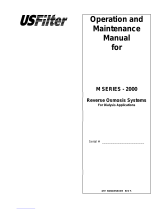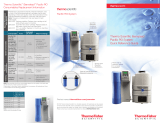Page is loading ...

Reverse Osmosis
User’s Manual
Model
LT-200, LT-300
LT-300 Pictured

2
ENGF-110 REV. A 01/11 © 2011 AXEON Water Technologies
This Page
Left Blank

3
ENGF-110 REV. A 01/11 © 2011 AXEON Water Technologies
Table of Contents
INTRODUCTION ....................................................................................................................................... 4
SAFETY .................................................................................................................................................... 4
FEED WATER & OPERATION SPECIFICATIONS .................................................................................. 5
REJECTION, RECOVERY, & FLOW RATES ........................................................................................... 5
SYSTEM INSTALLATION AND START-UP PROCEDURES .................................................................. 6
MEMBRANE ELEMENTS ......................................................................................................................... 8
LT-200, LT-300 SYSTEM IDENTIFICATION .......................................................................................... 12
LT-200 MEMBRANE FLOW DIAGRAM .................................................................................................. 15
LT-300 MEMBRANE FLOW DIAGRAM .................................................................................................. 16
DESIGN BASIS FOR LT-200, LT 300 .................................................................................................... 17
OPERATING DO’s & DON’Ts ................................................................................................................. 18
MAINTENANCE PROCEDURES ........................................................................................................... 18
MEMBRANE REMOVAL & REPLACEMENT ......................................................................................... 20
PREPARING UNIT FOR STORAGE OR SHIPMENT ............................................................................ 22
REVERSE OSMOSIS TROUBLESHOOTING ........................................................................................ 23
TEMPERATURE CORRECTION FACTORS FOR MEMBRANE ........................................................... 25
OPERATION ........................................................................................................................................... 27
DRAWINGS............................................................................................................................................. 28

4
ENGF-110 REV. A 01/11 © 2011 AXEON Water Technologies
INTRODUCTION
Your LT-Series system is a durable piece of equipment which, with proper care, will last
for many years. This User’s Manual outlines installation, operation, maintenance, and
troubleshooting details vital to the sustained performance of your system.
The test results which are included with this User’s Manual indicate your system’s
permeate (product) and concentrate (waste) test results.
If your system is altered at the site of operation or if the feed water conditions change,
please contact your local dealer or distributor to determine the proper recovery for your
application.
NOTE: IN ORDER TO MAINTAIN THE MANUFACTURER’S WARRANTY, AN
OPERATING LOG MUST BE MAINTAINED AND COPIES WILL NEED TO BE SENT TO
YOUR LOCAL DEALER OR DISTRIBUTOR FOR REVIEW.
NOTE: PRIOR TO OPERATING OR SERVICING THE REVERSE OSMOSIS
SYSTEM, THIS USER’S MANUAL MUST BE READ AND FULLY UNDERSTOOD. KEEP
THIS AND OTHER ASSOCIATED INFORMATION FOR FUTURE REFERENCE AND
FOR NEW OPERATORS OR QUALIFIED PERSONNEL NEAR THE SYSTEM.
SAFETY
The Safety section of this User’s Manual outlines the various safety headings used
throughout this manual’s text and are enhanced and defined below:
NOTE: INDICATES STATEMENTS THAT PROVIDE FURTHER INFORMATION AND
CLARIFICATION.
CAUTION: INDICATES STATEMENTS THAT ARE USED TO IDENTIFY
CONDITIONS OR PRACTICES THAT COULD RESULT IN EQUIPMENT OR OTHER
PROPERTY DAMAGE.
WARNING: INDICATES STATEMENTS THAT ARE USED TO IDENTIFY
CONDITIONS OR PRACTICES THAT COULD RESULT IN INJURY OR LOSS OF LIFE.
FAILURE TO FOLLOW WARNINGS COULD RESULT IN SERIOUS INJURY OR EVEN
DEATH.

5
ENGF-110 REV. A 01/11 © 2011 AXEON Water Technologies
DO NOT UNDER ANY CIRCUMSTANCE; REMOVE ANY CAUTION, WARNING,
OR OTHER DESCRIPTIVE LABELS FROM THE SYSTEM.
FEED WATER & OPERATION SPECIFICATIONS
Nothing has a greater effect on a reverse osmosis system than the feed water quality.
NOTE: IT IS VERY IMPORTANT TO MEET THE MINIMUM FEED WATER
REQUIREMENTS. FAILURE TO DO SO WILL CAUSE THE MEMBRANES TO FOUL
AND VOID THE MANUFACTURER’S WARRANTY.
OPERATING LIMITS
NOTE: HIGHER TDS AND/OR LOWER TEMPERATURES WILL REDUCE THE
SYSTEM’S PRODUCTION.
REJECTION, RECOVERY, & FLOW RATES
LT-Series reverse osmosis systems are designed to produce permeate water at the
capacities indicated by the suffix in the system’s name under the conditions listed
above. For example, the LT-300 produces 300 gallons per day of permeate water at
the listed operating test conditions.
The amount of total dissolved solids (TDS) rejected by the membrane is expressed as a
percentage. For example, a 98.5% rejection rate means that 98.5% of total dissolved

6
ENGF-110 REV. A 01/11 © 2011 AXEON Water Technologies
solids do not pass through the membrane. To calculate the % rejection, use the
following formula:
% Rejection = [(Feed TDS – Product TDS) / Feed TDS] x 100
Example:
98.5% = [(550-8.25)/550] x 100
NOTE: ALL TDS FIGURES MUST BE EXPRESSED IN THE SAME UNITS,
TYPICALLY PARTS PER MILLION (PPM) OR MILLIGRAMS PER LITER (MG/L).
LT-Series reverse osmosis systems are designed to reject up to 98.5% NaCl, unless
computer projections have been provided or stated otherwise.
The amount of permeate water recovered for use is expressed as a percentage. To
calculate % recovery, use the following formula:
% Recovery = (Product Water Flow Rate / Feed Water Flow Rate) x 100
Example:
28% = (0.14/0.50) x 100
NOTE: ALL FLOW RATES MUST BE EXPRESSED IN THE SAME UNITS,
TYPICALLY GALLONS PER MINUTE (GPM).
SYSTEM INSTALLATION AND START-UP PROCEDURES
1. Inspect the system for any damage that could have occurred during shipment.
Although our systems have been individually inspected, complete a quick inspection
of the fittings, tubing, and other components.
2. Please provide a reasonable amount of space for installation and leave 6 inches of
space below the filter housings for ease of maintenance.

7
ENGF-110 REV. A 01/11 © 2011 AXEON Water Technologies
NOTE: THE REVERSE OSMOSIS SYSTEM SHOULD BE INSTALLED
INDOORS AND IT IS SUGGESTED THAT IT NOT BE IN DIRECT SUNLIGHT OR
EXTREME COLD.
3. Connect the 3/8” or 1/4” tube fitting to an incoming water source. The minimum
water pressure should be at least 30 psi. The system’s minimum operating pressure
is 80 PSI, but the optimum operating pressure is 100 psi.
NOTE: DO NOT OPERATE AT A PRESSURE EXCEEDING 125 PSI. The
operating pressure can be increased on the face of the booster pump by turning the
hex screw clockwise.
4. Connect the concentrate 1/4” tubing (waste) line to drain.
5. Plug the booster pump transformer into a power supply of 110 or 220 volts.
6. This system has been designed with an auto-flush restrictor. This restrictor
automatically flushes the reverse osmosis system for 30 seconds every time it starts
up and once every hour when the system is producing water.
NOTE: THE TANK PRESSURE SWITCH WILL SHUT THE SYSTEM OFF
AUTOMATICALLY, WHEN THE BLADDER TANK IS FULL.
7. The sediment filter and carbon must be serviced regularly for optimal performance.
The filters and water quality should be checked every two weeks minimum.
8. Dispose of the product water until the conductivity of the product water reaches your
desired level. Use any TDS or Conductivity meter to monitor the product water
quality. A minimum quality of 96% NaCl rejection is recommended.

8
ENGF-110 REV. A 01/11 © 2011 AXEON Water Technologies
NOTE: ANY CHLORINE EXPOSURE WILL DAMAGE THE MEMBRANE
PERMANENTLY.
9. This system has been factory wired and preset with a pressure switch at 20 - 40 psi,
which is only to be used with a pressurized bladder tank. If using an atmospheric
storage tank, a float switch will be required to turn the system ON and OFF.
MEMBRANE ELEMENTS
LT-Series reverse osmosis systems come pre-loaded with Thin Film Composite (TFC)
HF4 High Flow Low Energy membranes, unless otherwise specified. General
membrane element performance characteristics are listed on the next page.

9
ENGF-110 REV. A 01/11 © 2011 AXEON Water Technologies
HF4-STANDARD

10
ENGF-110 REV. A 01/11 © 2011 AXEON Water Technologies
NF3-OPTIONAL

11
ENGF-110 REV. A 01/11 © 2011 AXEON Water Technologies
NF4-OPTIONAL

12
ENGF-110 REV. A 01/11 © 2011 AXEON Water Technologies
LT-200, LT-300 SYSTEM IDENTIFICATION
FIGURE 1A
NUMBER IDENTIFICATION
1. Solenoid Valve – Turns On/Off Feed Water
2. 5 Micron Sediment – Removes particulates
3. 10 Micron Carbon Block - Removes Chlorine
4. GAC Polishing- Removes Chlorine, odor and taste
5. RO Pump - Pressurizes RO System
6. Pressure Gauge – Measures Pump discharge pressure
7. Pressure Switch – Turns the Pump off at 40 PSI feed pressure
8. Permeate Check Valve – Protects membranes from back pressure
9. Flow Restrictor – Restricts flow on the concentrate line
10. Pressure Vessel – Houses Membrane Elements

13
ENGF-110 REV. A 01/11 © 2011 AXEON Water Technologies
FIGURE 1B
FIGURE 1C

14
ENGF-110 REV. A 01/11 © 2011 AXEON Water Technologies
FIGURE 1D

15
ENGF-110 REV. A 01/11 © 2011 AXEON Water Technologies
LT-200 MEMBRANE FLOW DIAGRAM
FIGURE 1E
Note: Black arrows represent concentrate water and white arrows represent permeate
water.

16
ENGF-110 REV. A 01/11 © 2011 AXEON Water Technologies
LT-300 MEMBRANE FLOW DIAGRAM
FIGURE 1F
Note: Black arrows represent concentrate water and white arrows represent permeate
water.

17
ENGF-110 REV. A 01/11 © 2011 AXEON Water Technologies
DESIGN BASIS FOR LT-200, LT 300
WARNING: NEVER EXCEED THE MAXIMUM PRESSURE RATING OF
YOUR SYSTEM.

18
ENGF-110 REV. A 01/11 © 2011 AXEON Water Technologies
OPERATING DO’s & DON’Ts
DO:
Change the cartridge filters regularly
Monitor the system and keep a daily log
Run the system, as much as possible, on a continuous basis.
Always feed the pump with filtered water.
DON’T
Permit chlorine to enter or be present in the feed water.
Shut down the system for extended periods.
Operate the system with insufficient feed flow.
Operate the pump dry.
MAINTENANCE PROCEDURES
1. Periodically observe the quality and quantity of product water from the system.
NOTE: CHECK THE FEED WATER PRESSURE GOING INTO THE
REVERSE OSMOSIS MEMBRANE, A SIGNIFICANT DROP IN PRESSURE
COULD INDICATE A FOULED PRE-FILTER.
2. A 20% increase in TDS when checking the permeate water indicates possible
membrane damage and the membrane may need to be replaced.
3. It is suggested that a hand held TDS digital meter is used once per week to monitor
the water quality.

19
ENGF-110 REV. A 01/11 © 2011 AXEON Water Technologies
NOTE: IF THE TDS OF THE FEED WATER EXCEEDS 1000 PPM OF NACL,
A LARGER FLOW RESTRICTOR SHOULD BE USED TO EXTEND THE
MEMBRANE LIFE.
4. It is important to maintain and/or replace the carbon block regularly since the Thin
Film Composite membranes are chlorine sensitive. Irreversible damage will occur
with any chlorine present in the feed water. For additional information please review
the manufacturer’s membrane specification sheets.
5. The product line has a one way check valve installed. The check valve should be
checked regularly and replaced if not properly sealing.
6. Keep the feed water temperature above 4°C (36°F).
NOTE: EXTREMELY COLD FEED WATER WILL LOWER THE PRODUCT
WATER OUTPUT AND INCREASE PUMP PRESSURE.

20
ENGF-110 REV. A 01/11 © 2011 AXEON Water Technologies
MEMBRANE REMOVAL & REPLACEMENT
Replacing membranes in the pressure vessels is an easy process if you have the
proper information and tools at hand. Please refer to the following instructions when
removing and replacing membrane elements:
WARNING: ALL PRESSURE GAUGES MUST READ ZERO BEFORE
PROCEEDING. BEFORE ATTEMPTING, DISCONNECT THE POWER FROM THE
SYSTEM AND BLEED ALL WATER PRESSURE FROM THE SYSTEM.
1. Remove the end caps from the top of the membrane housings. This is done by
removing the white snap ring of the membrane housing.
2. Remove the membrane bag containing the membrane element from the shipping
box.
WEAR GLOVES FOR THE FOLLOWING STEPS IN ORDER NOT TO
CONTAMINATE THE MEMBRANE.
3. Cut the bag open as close as possible to the seal at the end of the bag, so the
bag may be re-used if necessary.
4. Make sure that all parts are clean and free from dirt. Examine the brine seal, and
permeate tube for nicks or cuts. Replace the O-rings or brine seal if damaged.
5. Flow directions should be observed for installation of each element into each
housing.
As time progresses, the efficiency of the membrane will be reduced. In general, the salt
rejection does not change significantly until two or three years after installation when
operated on properly pretreated feed water. The permeate flow rate will begin to decline
slightly after one year of operation, but can be extended with diligent flushing and
cleaning of the system. A high pH and/or precipitation of hardness can cause
premature loss in rejection.
REPLACING THE MEMBRANE ELEMENT:
WARNING: THE BRINE SEAL MUST BE IN THE SAME POSITION FOR
EACH MEMBRANE ELEMENT HOUSING, SO MARK EACH HOUSING PRIOR TO
REMOVING THE MEMBRANE ELEMENTS. THE BRINE SEAL IS A RUBBER SEAL
/







